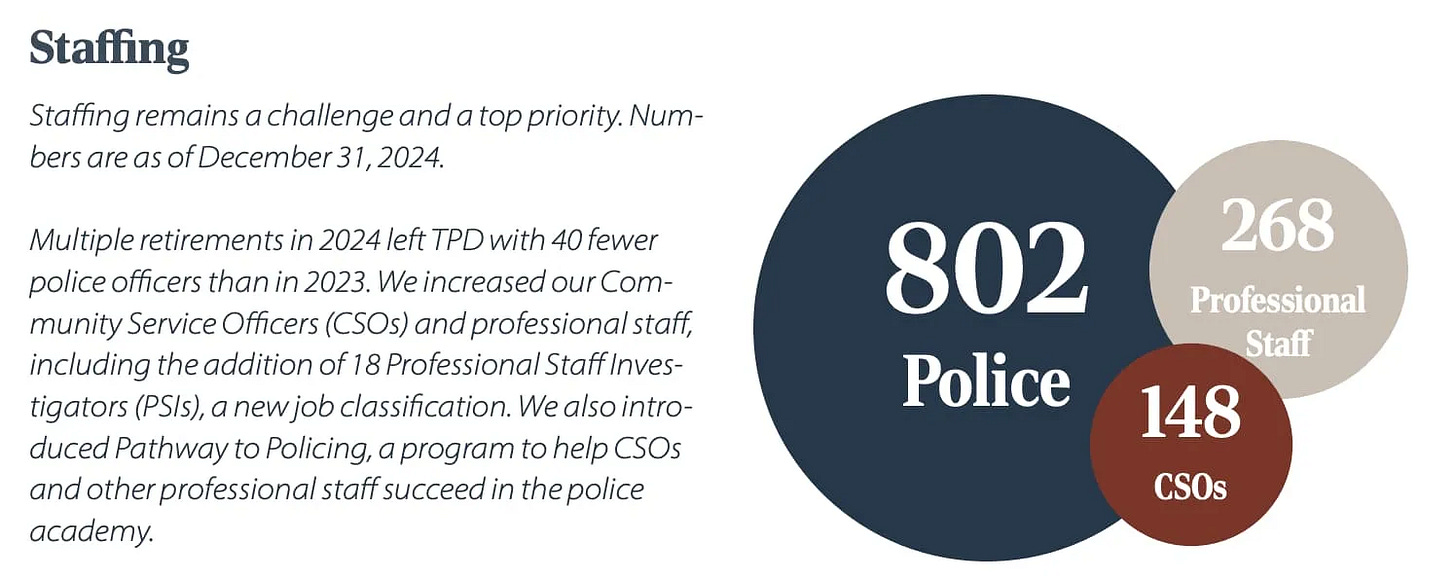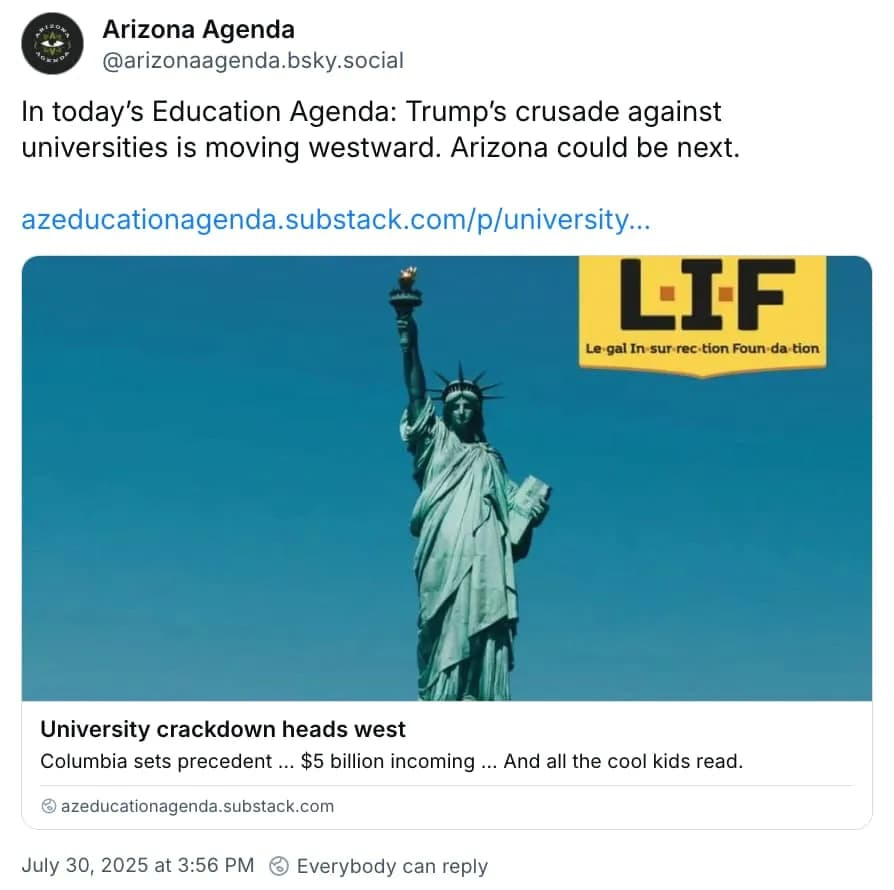Waiting on a raise
Police and fire get left out … Another Project Blue showdown … And who else remembers steak pants?
Last month, about 600 City of Tucson employees got a letter from the Human Resources Department letting them know that a promised pay raise was going to be roughly half of what had been originally advertised.
The reason? These employees — roughly 12% of the city’s workforce — were already making the maximum allowed for their pay grade. So instead of the expected 1.5% raise, they only received a 0.75% increase.
City records show about two-thirds of those impacted were first responders.

In a memo to the Council, City Manager Tim Thomure said the employees were “red-circled” because their current salaries already exceed the top of their pay ranges.
“These staff, commonly referred to as being ‘red circled,’ have been notified and the adopted compensation plan for FY-26 was explicit that they would receive half of the adjustment,” Thomure wrote in the memo.
For police officers and firefighters, this means their overtime from the past year pushed them beyond their base salary.
Thomure also noted the Council had approved a multi-year strategy to address employee compensation, and the 1.5% raise was only one part of that plan.
Last month, the city launched a new performance evaluation system and awarded raises to about 500 employees based on their experience.
In October, the city will make market adjustments for staff in many departments, Thomure said, including most police and fire personnel. He also said compensation will be part of the conversation during next year’s budget process.
“Mayor and Council have placed a high priority on creating a fair, market-based compensation system for all employees. Under the FY-26 adopted budget, we allocated significant new funding to implement a complex, multi-year employee investment plan to address pay issues,” he said.
That got us thinking — how much are Tucson police officers and firefighters actually making?
So we filed a public records request for their salary data, including base pay and supplemental compensation like overtime and bonuses.1
We analyzed pay for police officers, lieutenants, and detectives. The median figure for these employees earned overtime and bonuses totaling $27,000 more than their base pay in 2024.
The median base salary for Tucson Police officers and supervisors was about $69,000. With all supplemental pay included, that number jumped to about $96,000.
That extra pay includes mandatory calls to officers to come in when they are not scheduled for major crashes, homicides, academy instruction shifts stacked on top of regular patrols. And it includes special duty pay — usually working security for private businesses. Those businesses reimburse the city for the officer’s full pay, including overtime.
Several dozen officers made more in overtime than they did in base pay, pushing their total compensation well into six figures. A crime scene specialist made $215,000 on paper by clocking a massive amount of overtime — nearly matching the salary of Police Chief Chad Kasmar.
To some extent, overtime is unavoidable because of chronic staffing shortages.
While the department is authorized to have 880 patrol officers, only about 820 are currently on the payroll — and that figure includes academy trainees. After factoring in medical leave, vacation, and other absences, the average number of deployable officers is around 750.
That number is almost identical to what the city had in 1989. Staffing was significantly higher just before the Great Recession, but the city has struggled to recruit and retain officers for more than a decade, despite repeated funding increases from the Council.

Several Tucson City Council members have long complained about TPD staffing shortages. But voters overwhelmingly rejected Proposition 414, which would have added more officers.
Shortly after that vote in May, Mayor Regina Romero signaled interest in working with the community on what we’ve dubbed “Proposition 415” — a new sales tax measure to tackle critical needs in Tucson.
At last week’s Project Blue public meeting, Thomure suggested that the potential $10 million in annual revenue from such a tax could help support services, including the police department.
Councilmember Paul Cunningham told the Tucson Agenda he’s working on proposals to redirect special revenues this year to boost police staffing — both through new hiring and better retention.
As for the Tucson Fire Department, the numbers are similar.
TFD continues to see year-over-year increases in emergency call volume. This summer, they also began responding to certain calls in South Tucson, especially when more than one engine is needed for incidents like structure fires.
Our calculations show that firefighters averaged about $26,000 more than their base pay last year.
The median base salary for Tucson firefighters and supervisors was about $63,000. With all supplemental pay included, that number jumped to about $93,000.
We’ll be watching to see if the Council acts on plans to re-evaluate employees or find new ways to put more funding in the police department budget.
Paying police officers is one of the touchiest political topics out there, particularly in the wake of the “defund the police” movement and the backlash that followed.
What do you think? Should Tucson police officers get a raise?
Were you surprised to see how much officers make when overtime is included?
Do you think Tucson officials should focus on enticing more people to become police officers? Or would that money be better spent on affordable housing or other issues?
Let us know in the comments!
Another public meeting on Project Blue, this time online, revealed a few more key details about the planned data centers in Tucson.
Here are three big questions they (mostly) answered:
Question #1: Will you use local labor?
Yes, according to Beale Infrastructure, the developer of record.
“Hiring locally just makes sense,” said Arnaud Dusser, Beale’s director of development.
Dusser told the audience that importing out-of-town labor wouldn’t be cost-effective — and relocating talent from other cities isn’t practical.
This matters to local labor unions, which have backed Project Blue at public meetings and in op-eds. They’re eyeing the estimated 3,000 construction jobs expected over the next three years.
One thing missing: a formal labor agreement between Beale and local unions. But that’s likely premature until the Tucson City Council votes on whether to annex the project.
Question #2: What about cooling towers?
The data centers won’t use cooling towers, said Christina Casler, Beale’s director of water — though final designs haven’t been released.
Cooling towers are notoriously inefficient, wasting water through evaporation and “drift,” where moisture escapes through airflow.
Casler didn’t say what cooling system the project will use.
Question #3: Can TEP manage demand?
Yes — for now.
Tucson Electric Power says it can handle electricity needs for the first four data centers, partly due to a new agreement to increase supply. Later phases are less certain.
Ryan Anderson, TEP’s Manager of Business Development, said future demand will be met through additional agreements with other utilities. Beale will pay for all added capacity and shares TEP’s goal of using carbon-free energy and phasing out coal.
Within 60 days, TEP and Beale plan to release a joint roadmap to develop long-term carbon-free power sources.
The Education Agenda
Ivy League schools have borne the brunt of the Trump administration’s crackdown on higher education.
But that’s no longer the case. Federal education officials are now going after schools as far west as Nebraska. Which raises the question: How long until Arizona’s universities get hit?
In this week’s edition of the Education Agenda, we shine a light on the $221 million price tag to get the Trump administration off your back and give you the skinny on a conservative group that’s taking center stage in the crackdown.
Subscribe to the Education Agenda to get up to date on what’s shaking the higher education world to its core and the local controversies that are top of mind among Arizona school officials.
The A.I. Agenda
The global power struggle over artificial intelligence hit a new stage last week.
Both China and the U.S. unveiled their strategies for winning the AI race. And there are some stark differences to unpack.
In this week’s edition of the A.I. Agenda, we sketch out the Trump administration’s “Build, baby, build!” strategy and what it means for Arizona’s builders, CEOs, and environmentalists.
We also dive into AI-powered price hikes, surprising hiring drives, a news company that’s leaning on AI and much more.
Subscribe to watch the Age of AI unfold in real time.
The Water Agenda
The push by Sedona residents to build an expensive underground water tank is creating quite a dilemma for their neighbors in nearby towns.
To understand the nuances of the situation, you have to look in some unexpected places, like theories of rationality and British game shows.
Good thing our resident water expert has been hitting the books and bingeing “Golden Balls,” so he can lay it all out for you in this week’s edition of the Water Agenda.
But that’s not all you’ll get if you subscribe to the Water Agenda.
We also check in on a water dispute playing out on the Colorado Plateau, a tough report on data centers, and everything else you need to know about Arizona’s water world.
Our sister newsletter, the Arizona Agenda, asked readers this week for stories about “the best Arizona political cheaters.”
Reader Corinne Cooper brought up one of the more hilarious incidents in local political history — when it came to light that 2011 mayoral candidate Ron Asta had once been caught shoplifting a steak in his pants.
The steak part is funny. The rest of Asta’s political story is wrapped up in tragedy.
Also, the steak pants link above took us down a rabbit hole that reminded us that the Tucson Weekly once bought up all the local politicos’ domain names (like ReginaRomero.com — which is currently hosting a shoe store) just to teach them a lesson about self-promotion during an election.
Candidates, you have been warned.
Our methodology used the full burden rate and included a handful of pay codes that some might take issue with. But, for example, every officer gets a $1,000 annual bonus that’s included in their paycheck.










As a former manager who handled police salary negotiations locally, I can say that we might consider different metrics. The public safety sector unions here will always point to Maricopa County for comparisons. Maybe we should be looking at crime rates per thousand to learn the effectiveness of departments with competing salary schedules. Are we getting “our money’s worth” per hours paid? (Yes, I know reporting differences produce wanky numbers). But we need to look past merely comparing salaries and benefits.
With all this said, I do believe local first responders should be paid competitively.
Joe, Thanks for the update. You know I've been doing economic development in one form or another for 30 years, and this whole NDA/secrecy thing is just weird. Not to be paranoid, but there's more here than meets the eye.